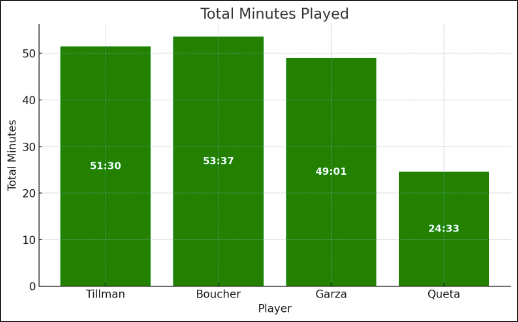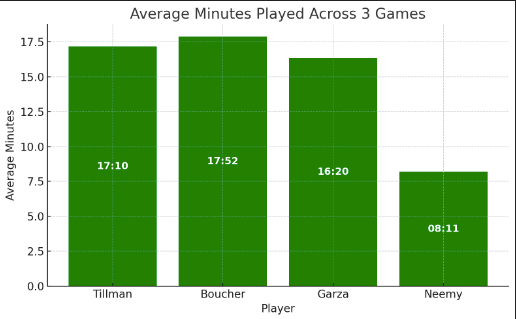Are the Boston Celtics leaning into a center by committee approach?
Joe Mazzulla has been giving every big man a chance to shine.
Center by committee?
That’s the early read.
Through three preseason games, Joe Mazzulla’s rotations have been a revolving door in the middle of the floor — and nobody has separated themselves…yet.
After losing Kristaps Porzingis, Al Horford, and Luke Kornet this summer, it was inevitable that the bigs in Boston’s rotation would be sucked into a battle for minutes. In truth, there isn’t a starting-caliber center on the roster — at least, not from what we’ve seen so far.
Rather than committing to a single big man, Mazzulla’s used the early preseason to experiment with his rotations and substitution patterns.
Outside of Neemias Queta, the minutes have been split fairly evenly. Chris Boucher has logged a good chunk at the four, sometimes next to Luka Garza in double-big looks.
Nevertheless, Mazzulla is clearly searching for the right fit, both with the starters and off the bench. In fairness to Queta, part of his limited minutes may be due to his time with Portugal at EuroBasket. However, he’s done himself no favors with his showing in the preseason.
I’ve been low on the idea of Queta as a starting center all summer. The preseason hasn’t changed that. Even if he’d played in Boston’s first game, his total minutes still trail the pack.
Even if Queta had played in the opening game of the preseason, judging by his total minutes distribution, he would still be trailing the rest of the pack with 36 minutes of playing time. Garza appears to be putting his best foot forward in the battle of the bigs, showcasing solid screening ability, rebounding skill and the willingness (and skill set) to stretch the floor on pick-and-pop scenarios.
In Xavier Tillman, the Celtics have a small-ball five who can switch on the perimeter, bang down low and operate as a facilitation hub on offense. He may need to become more aggressive in how he positions himself as a release valve, but so far, he’s looked good in terms of movement and timing.
Boucher has arguably been the most impressive of the quarter, showcasing his two-way production along with knocking down his fair share of threes. However, it’s likely that he primarily plays at the four, sliding into the five when matchups dictate or when Mazzulla is looking for added pace without giving up the size that occurs when Tillman is on the floor.
So what should we expect?
Right now? Probably more of the same.
Preseason, like the opening weeks (if not months) of the regular season, is about experimenting. Mazzulla will eventually need to settle on a defined rotation. But that need isn’t going to arise in 2025. Instead, it will occur as we edge closer to the All-Star break, or when the Celtics return from those festivities.
I find it hard to believe Queta is so far down the rotational pecking order, too. At some point, it’s fair to expect he will get his shot with a sizeable role in the rotation. Whether he can capitalize on that opportunity will remain to be seen. However, until Mazzulla has all the necessary data points, I would expect to see the committee approach continue.
At the moment, I’m leaning toward either Tillman or Garza securing the starting five spot, with Boucher at the four. Not only does that allow Boston to play at pace, but it gives them a rebounding presence and some trail man offense — which could work well if their drives suck in opposing defenses and leave Garza to do his thing off the catch (be it shoot, drive or re-share the rock around the perimeter).
…There are some other options
Mazzulla sticks with a committee approach all season.
There’s nothing wrong with sharing the developmental minutes around and leaning into fresh legs throughout the year. In fact, that could be beneficial to everyone involved, as they all get legitimate playing time, and their matchups would likely be tailored to their strengths and weaknesses.
Rather than having a de facto starter and a rigid rotation, Boston would have four players who can hop in and out of the lineup when needed. If someone starts to emerge as the obvious first choice, then you adjust and begin to run with it. If not, you chop and change as often as deemed necessary. None of the bigs will have big expectations for minutes, either, so keeping everyone locked in should be fairly straightforward.A new big enters the equation on or before the Feb. 5 trade deadline.
I know, it’s easy to get attached to the guys on the roster. I’m already sold on Josh Minott being a “sticky” addition to the rotation and I think Garza could go the same way. However, the smart move — at least in my opinion — is not to get too married to any of the non-core guys. There’s a chance that some of them end the year elsewhere.
If Brad Stevens does choose to make a trade, finding a long-term solution in the middle of the floor could, and potentially should, be near the top of his priority list. Whether that opportunity presents itself is another story, but we can all hope, right?
If a starting-level big suddenly walks through the door, then Mazzulla can adjust. However, until we get a solid read on what the next iteration of this team will look like, from a playstyle standpoint, it’s hard to visualize what type of big would fit into the puzzle.
In truth, it may be worth waiting until Jayson Tatum is back in the rotation, at least then you can see how his presence alters the style of play. Then finding the right big man should become an easier task — landing him via trade or free agency…Not so much.
Developing through competition
Mazzulla has been coaching his roster hard during the preseason. I’ve been a huge fan of his approach regarding rebounding and sending a message with his substitution patterns. That approach, coupled with the ongoing battle for playing time, should help his younger, unproven players to begin taking steps, if not leaps, in their development.
The same can be said for how the bigs are currently being used.
If no one is guaranteed a starting role, or even a consistent high-minutes spot off the bench, then everyone is forced to work harder. The notion of incremental improvements becomes key to staying relevant in Mazzulla’s game plan. Weaknesses and limitations become areas to attack behind the scenes, and strengths become separators in the positional battle.
I came into the preseason expecting a defined big-man rotation. I’ll be leaving it expecting a broad competition that lasts well into, if not all of, the season.
For a team that’s retooling on the fly and trying to establish a new identity without its best player, every possession, every rebound, every rep matters. Mazzulla will be consistently figuring out who can survive in his system when the games start to count — both this season and in the years to come.
If that means “center by committee” becomes the new normal for a while, so be it. In fact, it might be the best option available.




Realistically Mazulla could never replace what Al and KP provided on offense. That's why I've been carefully watching how the new bigs perform in the roll, because Kornet's production and success could be replicated. I know Slimm Duck has been playing 5 but I think the competition is between Q, X, and Garza. Joe is giving X first dibs but X is too tentative on O which kills Cs approach. I think Garza will win the minutes eventually and secure the spot around game 15-20.
Have to with the current roster and adjust to the competition lineup. Don't think Tillman and Queta will be around by the deadline. Brad needs to try and acquire a Kessler, Gafford, Duop Reath, Day Ron Sharp, Thomas Bryant, Noah Clowney, Danny Wolf? Just not sure on Queta or Tillmans trade value